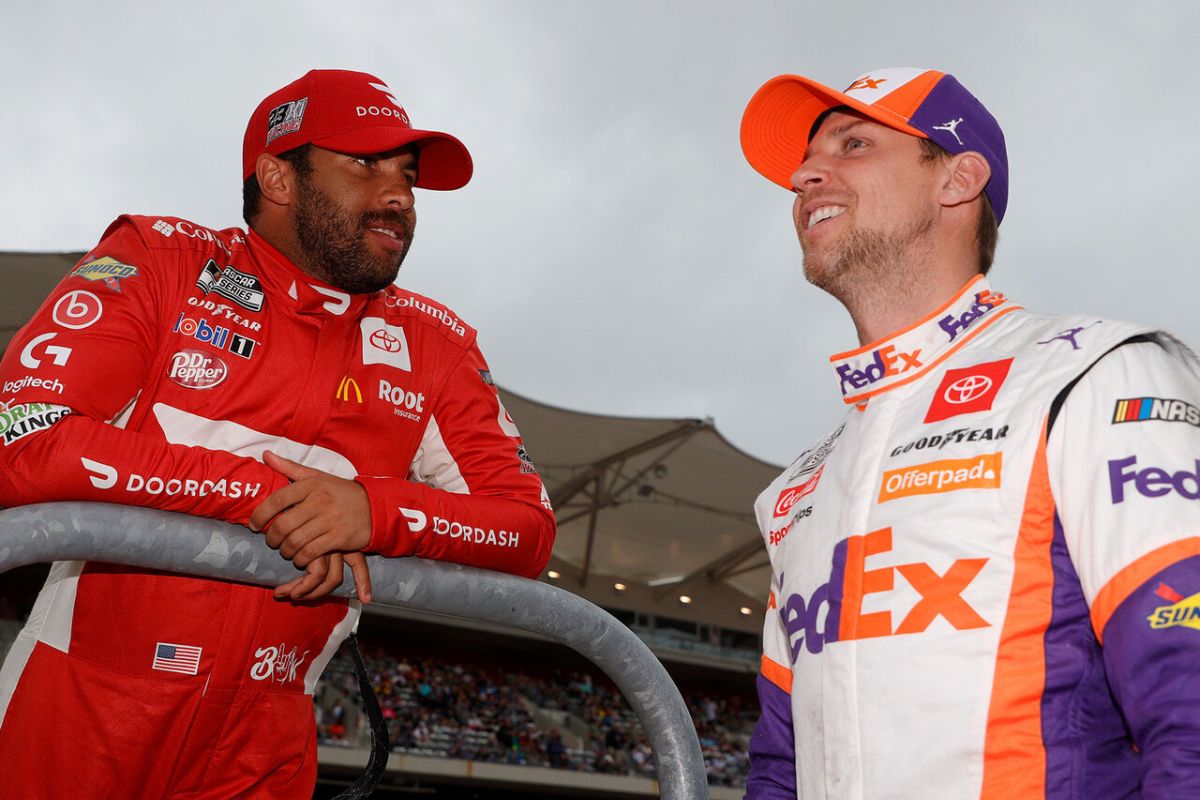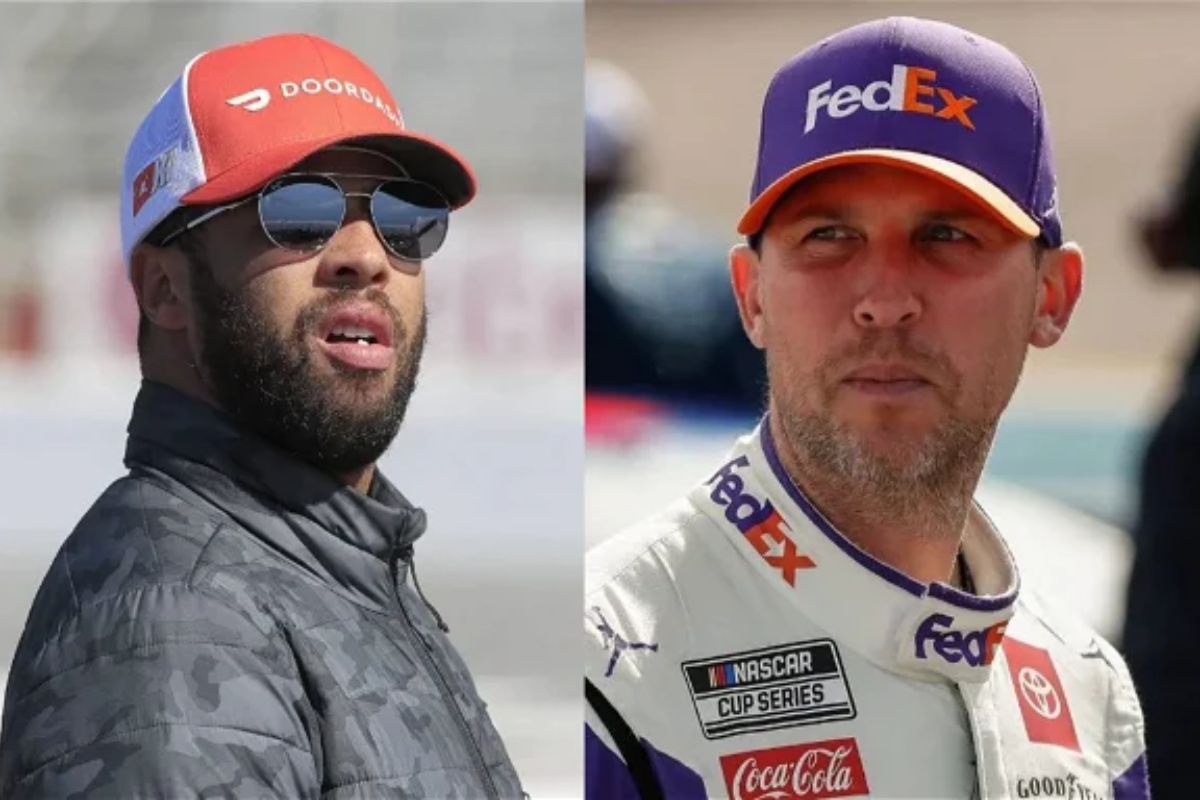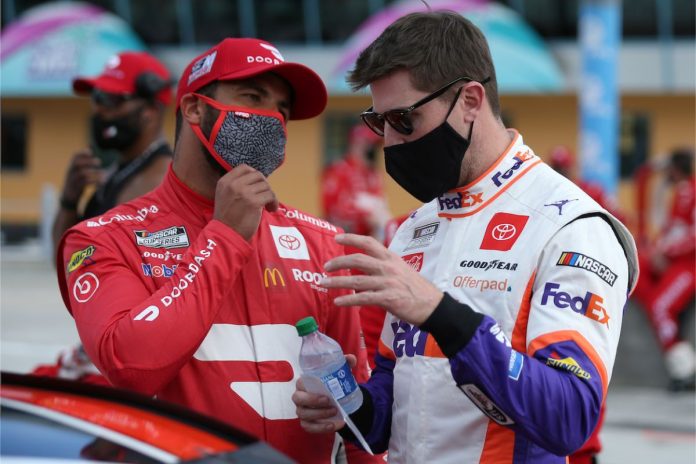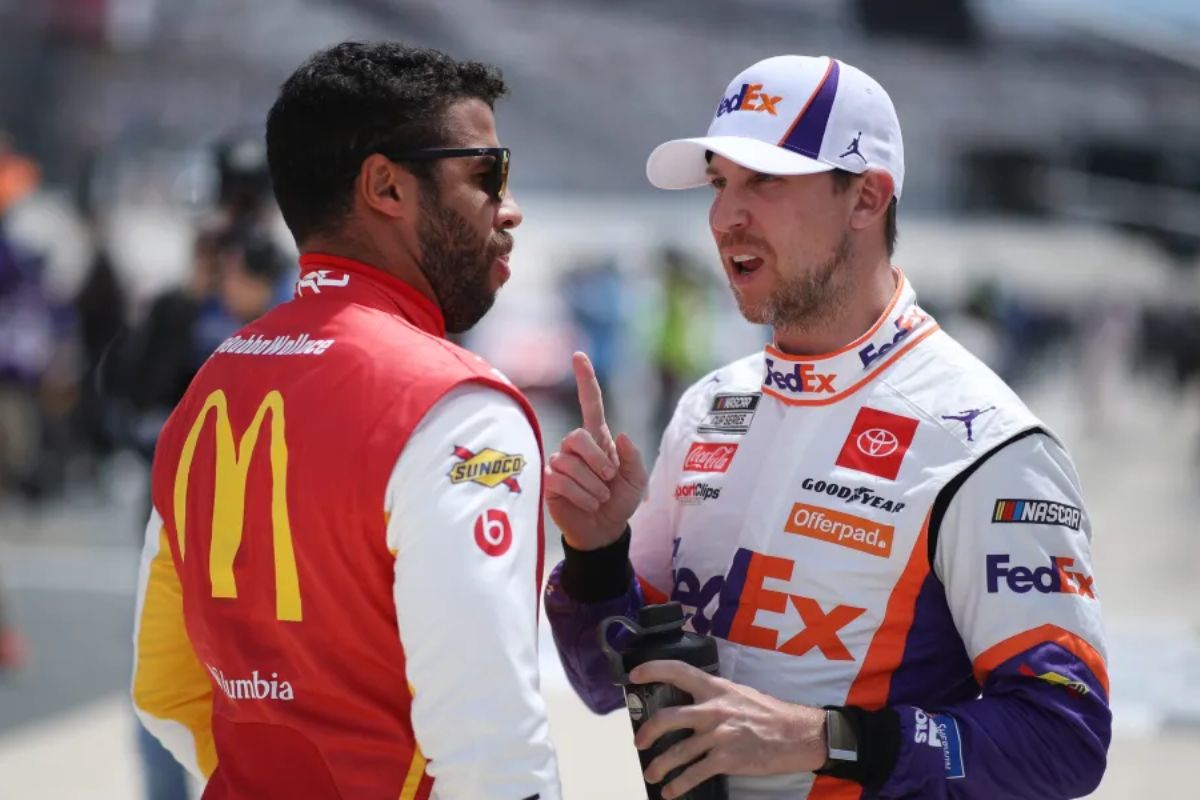Toyota Wipeout at Talladega: At the recent NASCAR event at Talladega Superspeedway, Alabama a strategic miscalculation by Toyota’s racing team highlighted a critical aspect of motorsport: the delicate interplay between team strategy and individual decision-making. In a bid for aerodynamic advantage, Toyota’s drivers attempted to maintain a single-file formation, a tactic that disastrously crumbled during Turn 3. The ensuing wreck not only sidelined contenders Denny Hamlin, Bubba Wallace, and Erik Jones but also sparked a debate over Wallace’s in-race decisions and their impact on team dynamics and safety.
Key Takeaways
- Toyota’s planned single-file strategy failed, leading to a crash involving Hamlin, Wallace, and Jones.
- The crash occurred when the team’s narrow formation broke down in Turn 3.
- Bubba Wallace’s aggressive maneuvers were critiqued by teammate Erik Jones.
- Denny Hamlin attributed the wreck to a critical driving error, emphasizing the complexities of team strategies at superspeedways.
- The incident underscored the importance of precise timing and spatial judgment in high-pressure racing environments.
Toyota’s Plan Turns Sour at Talladega
Toyota’s strategy at Talladega backfired dramatically when their attempt to streamline their positions led to a major collision involving key team drivers. With just 33 laps remaining, Toyota teams created a tactic to single-file align, a strategic formation intended to boost aerodynamic efficiency and speed past competitors. This strategic alignment was pivotal in setting up a strong finish, but it required precise execution and coordination among all team drivers.
The execution faltered in Turn 3. The critical moment saw Bubba Wallace’s No. 23 car compressed between Erik Jones and John Hunter Nemechek. This tight sandwiching was a direct consequence of the narrow, single-file positioning that left minimal room for error. The proximity of the vehicles, combined with the high speeds and inherent instability of the track’s turn, set the stage for the ensuing chaos.

Wallace’s Frustration and Post-Crash Reflection
Reflecting on the crash at Talladega, Bubba Wallace expressed significant frustration over the race’s outcome and the failed execution of their team strategy. The incident not only derailed his hopes for a strong finish but also highlighted the delicate nature of racing dynamics at superspeedways. Wallace, driving for 23XI Racing, was involved in a multi-car accident that greatly impacted Toyota’s presence in the race.
Wallace’s frustration stemmed from the team’s inability to maintain a coherent plan, which was pivotal for maneuvering the tightly-packed field at Talladega. Despite the collective intent to form a single file and push forward, the execution faltered under stress, leading to premature and aggressive positioning. This breakdown in teamwork and strategy not only cost Wallace a potential top finish but also reflected a broader issue of coordination among teammates under such conditions.
“We were all pushing really hard to keep our line going. We had a plan and just didn’t execute it as well as we should. You look forward to running these places, and you just get trapped in somebody else’s mess. But I hate it, doesn’t make us look good at all. We’ll just reset and go to Dover. We got a long way to go. We’re fine, just frustrating.”-Wallace’
Hamlin’s Unfortunate Involvement and Assessment
Denny Hamlin, caught in the multi-car wreck at Talladega, attributed the crash to a critical error made by one of the drivers in attempting an ill-timed move into a turn. Hamlin, a seasoned driver well-versed in the dynamics of pack racing, highlighted the inherent risks associated with aggressive actions in tightly packed fields. The nature of the Talladega Superspeedway, with its high speeds and banked turns, demands precision and timing in drafting and positioning. Hamlin’s analysis suggested that the disruption was not just a matter of chance but a significant lapse in judgment during a critical phase of the race.
“We were trying to do our best to run our own strategy there, and obviously we all wrecked each other. Somebody obviously made a mistake. Yeah, you can’t push in the corner, for sure. I don’t know who it started with or whatever, but you can’t push into the corner.”-Hamlin
Expanding on his perspective, Hamlin pointed out the tactical misstep: initiating a push in the corner, which is widely recognized among drivers as a risky action prone to causing instability. This action contradicts standard racing wisdom, which advises maintaining steadiness through turns and reserving aggressive moves for the straights where cars are better able to handle the added momentum. According to Hamlin, this miscalculation led to a chain reaction, impacting several drivers’ strategy for the race, including his own.
"A good plan gone wrong."
Here's what happened: https://t.co/AR82NWHMPJ pic.twitter.com/umNcyyc2GE
— FOX: NASCAR (@NASCARONFOX) April 21, 2024
Erik Jones Questions Wallace’s Moves
Amid the chaos of the Talladega wreck, Erik Jones openly criticized Bubba Wallace’s decision-making at turn 3, suggesting it precipitated the multi-car incident. Jones, who was directly involved in the crash, offered a detailed critique of Wallace’s tactics, which he believed played a critical role in triggering the extensive pile-up that ensnared multiple vehicles, including his own.
“Yeah, I’m a little sore, but it’ll be alright. I don’t know how the 23 was pushing us there, obviously. We were pushing and shoving, trying to make our strategy. You know I got pretty sideways getting into 3 and tried to gather it up into the wall. It’s unfortunate; I hate it for my team and my guys who wanted to work out and have a good run”-Jones
According to Jones, Wallace’s split-second choices at a pivotal moment of the race not only compromised vehicle safety but also strategical positioning that could have mitigated risks for the team and others on the track.
- Aggressive Tactics: Wallace’s assertive strategies in a densely packed field raised the risk of contact.
- Strategic Missteps: The choice to push the envelope at such an important point in the race was seen as a tactical error.
- Safety Concerns: Jones highlighted the disregard for the safety of fellow drivers, which is paramount in racing environments.
- Impact on Team Dynamics: Such incidents can strain relationships and team strategy, affecting future races.
Toyota’s Strategy Fails
In the environment of the GEICO 500 at Talladega, coordination among teammates is paramount, especially for manufacturer-based teams like Toyota. The race strategy typically involves forming a cohesive unit that can utilize drafting techniques to navigate and dominate the superspeedway effectively. This approach hinges on synchronized movements and timing, which, if executed correctly, minimizes risks and optimizes speed and control.
Unfortunately for Toyota, their strategy at this event did not unfold as planned. The Toyota drivers, including Erik Jones and Bubba Wallace, attempted to coordinate their movements to position themselves advantageously. However, the cohesion needed for such actions was noticeably lacking. Jones’ account of the incident highlights a critical moment where the intended strategy deteriorated—during a push from Wallace, Jones found himself losing control.

News in Brief: Toyota Wipeout at Talladega
The incident at Talladega highlights the complex challenges inherent in motorsport team strategies, especially on superspeedways. Toyota’s attempt at aerodynamic alignment through single-file racing emphasized the delicate balance between collective strategy and individual decision-making.
The resulting crash not only affected the race outcomes for Wallace, Hamlin, and Jones but also served as a crucial lesson in the dynamics of team cohesion and the severe consequences of its absence in high-speed environments.
Our Reader’s Queries
Q: What is Talladega known for?
A: Talladega, NASCAR’s longest oval at 2.660 mi (4.281 km), surpasses Daytona International Speedway’s length of 2.500 mi (4.023 km). Hosting up to 175,000 spectators, its main grandstand accommodates around 80,000 fans.
Q: Who owns Talladega?
A: ISC possesses 12 tracks hosting NASCAR events, spanning Daytona International Speedway, Talladega Superspeedway, Darlington Raceway, and Homestead-Miami Speedway. From New York to California, ISC, alongside Speedway Motorsports Inc., dominates major race facilities.
Q: How long is one lap at Talladega?
A:Talladega’s circuit, at 2.66 miles, surpasses Daytona and Indianapolis in length. Since its inception, Talladega’s biannual NASCAR races have consistently delivered high speeds and thrilling spectacles, achieving the goals set by its founders.
Also Read: Erik Jones Hospitalized: Talladega’s Tragic Crash Update



